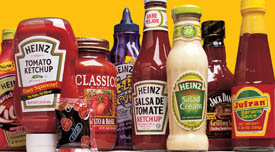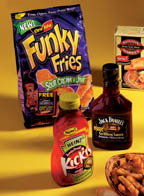It has one of the most successful lines of restaurant-branded products in history and the wide range of Ore-Ida products. It has StarKist and its related offerings. It has a successful appetizer business, thanks to acquisitions of Anchor Food Products and Delimex. Yet, talk to anybody on the street (or most people in the food industry, for that matter) and when “Heinz” is mentioned, the response will invariably be, “Yeah, the ketchup company.”
Indeed, “the ketchup company” has made notable innovations to the crimson condiment, but it also has ventured into other areas, with offerings that have found a market in the U.S. and around the globe.
All 'Round the World
Overall, Heinz's product introductions have been more skewed to North America, with about 60-65% of their new products and innovations in that area over the last four years. However, Bill Johnson, chairman, president and CEO at Heinz, expects that to change in the future, to the point where the ratio of new product introductions probably will be split more evenly between North American introductions and those made internationally.
Heinz has had some success in transporting and adapting its product ideas around the world. For example, EZ-Squirt ketchup (which so enthralled American youth with its various colors and specially designed packaging) has launched in Europe, Australia, South America and in a few areas of Asia. The whole idea of kids controlling fun (and the idea of color as a fun element) is popular with children, Heinz believes. It is a route to reaching the youngest consumers not only in this culture and geography but, also around the world.
Feed the Children
The idea behind EZ-Squirt came from the consumer, says Casey Keller, managing director, ketchup, condiments & sauces; and global category leader for ketchup, condiments and sauces. He recalls sitting in groups with kids aged 6-12 and discussing what would make ketchup easier and more fun for them. “We talked to them about their current difficulties with ketchup bottles and why these were not as much fun as they would like them to be.”These efforts led to several innovations that propelled EZ-Squirt to success. The first was a conical nozzle, allowing children to direct the ketchup stream and to control where and how they put it on their food. The consumer groups also suggested more colors to make their ketchup experience more fun, but they had another motive, also.
“They thought that would really identify it as a product for them and not necessarily for their parents,” says Keller. Another change toward that goal was the packaging. The bottle was made of a softer, more pliable plastic and shaped to fit smaller hands, so that it was easier to hold and control.
Heinz' technical packaging group worked collaboratively with suppliers to develop that special plastic bottle. These suppliers worked alongside Heinz technicians on consumer research, and Keller believes those efforts helped them to design the right functionality of the product.
“The fundamental principle is to get close to consumers and understand what they want,” says Keller. “Get marketing and R&D—and even sometimes some of the other functions—involved in understanding, so that when we design and develop a new product proposition, it is designed with the consumer in mind for optimum success and based directly on contact and feedback from them.”
And For the Adults
A similar consumer-oriented philosophy directed the development of ketchup with an older target audience. As Keller relates, Heinz has found that kids use more ketchup per capita than any other age group. Then, ketchup consumption slowly declines with consumers in their mid-20s and then plateaus with those in their early 30s. Heinz' challenge was to make ketchup more appealing to 20- to 30-year-olds.
Research and discussion with consumers found these adults seek a higher flavor profile. As Keller relates, “People like eating those foods that ketchup goes well with, and they tend to use a lot of different kinds of sauces for variety, to get a little more sophistication or a little more “pop” in their taste. We decided to make ketchup do more of that. We designed those products and worked with consumers (a lot of culinary work) to understand what would drive the optimum flavor profile and then worked with consumers and tested them to see how to deliver those products.”

Early consumer research indicates Kick'Rs is being used across a wide range of foods, including more chicken products. While consumers are enjoying Kick'Rs on traditional ketchup foods such as hamburgers, hot dogs, French fries and others, they also have tried the Smokey Mesquite, Hot & Spicy, and Zesty Garlic flavors with a variety of other host foods.

Formulating with Flavor
Implementing those new condiment flavors took much R&D effort at Heinz, which included what has become a major trend at food companies—the use of chefs with their culinary expertise in developing new products.“(Heinz's master chefs) are particularly adept at figuring out exactly what flavor profile you really want and then playing with it to find the right formulation to meet what consumers want and need,” Keller says. “We tend to use that capability particularly in formulation work, because formulation work is not all about science and chemistry. It's about taste and culinary artistry and kitchen logic, and we tend to tap into those kinds of resources.”
Heinz's research chefs played a distinct role in developing the Zesty Garlic flavor of Kick'Rs, helping developers determine how strong to make the garlic flavor, which type of garlic flavor to use, and how to make sure there was not too much aftertaste. In addition, their culinary expertise helped the company assure that the garlic flavor was compatible with the foods most likely to be used with the condiment. All of these are culinary and taste questions addressed, ideally, by a research chef.
Keller relates that work with research chefs is important to food companies and very important to Heinz, because the company's products are “all about delivering flavor—flavor as a condiment to food. Developers must understand the interaction of those flavors with the food and with the palate experience.”
Furthermore, James Hastings, vice president of R&D, Heinz, NA, believes chefs are an integral part of the new product development process. In addition to chefs on staff within Heinz, the company also utilizes other, third-party chefs. “These culinary artists fill a very important role between the eating experience at the table and what food scientists do to make a foodstuff that is actually commercialized and that can be manufactured in huge plants. (The chefs) really bring a perspective that sometimes has gotten lost between the food scientist and what consumer palates are really looking for.”
Listening to those consumers led Heinz to focus again on the seemingly mature ketchup market, when the company developed an organic version of its most well-known product. As Keller describes, “(The organic ketchup) came about because of a look at market trends and discussions with Heinz's consumer base. We found a small—but growing—interest in organic products and decided Heinz could meet that need for organic ketchup. We embarked on a technical project to look at how to get organic materials, process in organic fashion, and create a product that delivers a taste expectations of Heinz to consumers that have a high organic interest and need.”
Gambling on Boston Market
Consumer research plays a key role in Heinz's product introductions, but one in particular would find inconclusive results. Boston Market's bankruptcy notwithstanding, Heinz' development of its Boston Market line was risky simply from a consumer research standpoint. As Keller recalls, the Boston Market gravy was a particular concern.
As Jeff Berger, president, Heinz Foodservice, relates, “It is important for (Heinz) to provide what customers truly need, and it is equally important to keep our Heinz brand front and center. Those are great challenges in today's marketplace, but ones that I believe we are meeting head-on.”
Heinz is doing so by continuing to improve and ease food preparation. For example, now in test market is EZ-Marinader, a resealable bag filled with pre-portioned marinade; all the consumer has to do is put the meat inside. The new product actually works better than traditional marinating, says Keller, because it encloses the meat inside the bag with the marinade, rather than just exposing one side in a pan. It saves on clean-up, as the bag can be thrown away, and it also helps from a food safety standpoint—the raw meat contaminates only the bag.
Such a consumer-driven philosophy has led Heinz to add new flavors to StarKist tuna, which now is found in pouches. Ore-Ida French fries saw its range extended to include five new Funky Fries flavors—sour cream & chive, cinnamon-covered potatoes, chocolate-covered potatoes, blue fries, and fry rings. Heinz brought Jack Daniels to the grill, while growing to include Anchor Food and Delimex appetizer offerings.
As a whole, Johnson expects the food industry to see more line extensions, which are a safer risk for new product developers. In addition, expect a focus on flavor, particularly among young adults, who are looking at non-traditional flavors. He also predicts a focus on convenient packaging for smaller households. This will be evident in smaller sizes and more convenient/more environmentally friendly packaging, as well as a continued shift toward innovations such as pouches and immediately-consumable packaging.

Sidebar: Heinz Talks R&D
Heinz' innovations and successes owe much to the research aspect of R&D. “Whether it's colored or upside-down ketchups, tuna in a pouch, or Jack Daniels sauces,” James Hastings, vice president of R&D, Heinz, NA, says, “we have truly gone out and asked consumers what they want. In the past, that was not a strength (at Heinz). We now focus up-front to try to understand what it is that consumers and customers are looking for.”That philosophy is regarded as a virtue among the principals at Heinz. In fact, Casey Keller, managing director, ketchup, condiments & sauces and global category leader for ketchup, condiments & sauces, has one piece of advice for food scientists: communicate with the consumer, with the manufacturers, with the suppliers, to understand as much as possible about how the end user experiences the food.
Heinz' new product development reflects that collaborative spirit. The marketing department works with R&D to create the idea, the prototype, the proposition, and is directly responsible for the concept and positioning, as well as the advertising of the new product. However, the group also is involved in understanding the consumers' wants and needs, providing insights behind the product, and helping to design and develop the parameters of the new product.
The R&D department, itself, is structured as a matrix-type organization, says Hastings. This allows the group to provide R&D support to individual businesses (be it foodservice, condiments, frozen foods, etc.), with the structure organized so that efforts are reported up through Hastings. With this setup, Heinz can take advantage of the efforts expended on one division to see if there might be opportunities with that product or packaging in another of the divisions. “It could be a new package, a condiment, a process,” Hastings says, “but we are actively making sure that we transfer something that may be under development in one business into any of the other businesses where there might be application. There is a focus, certainly, to support (current projects) but, also, a real effort (to not) reinvent the wheel on each business.”
As Jeff Berger, president, Heinz Foodservice, explains, Heinz developers strive to work together with their counterparts in the company's various divisions. “We're all working toward a common goal, so that makes sense for us. One great example of synergy: Heinz Frozen Foods acquired Delimex, and this has presented a huge opportunity for us in foodservice to take those products to market. We think this will be a win-win for both of us.” In his 11-plus years at Heinz, Hastings has seen two philosophies dominate the company's R&D efforts. When he first arrived, R&D's role was to support manufacturing and to pull costs out of the equation. Over the past several years, that focus has leaned more heavily toward innovation.
“We have really focused over the last several years on innovation,” says Bill Johnson, chairman, president and CEO, “not only in marketing but throughout everything we do—innovation in packaging, innovation in line extensions, the reinvigoration of what had, historically, been considered mature brands. So for us, the role of innovation is really the key, and that means creating a stimulating environment that allows us to improve the businesses we are in and add new businesses through new products or other processes that take advantage of that.”
